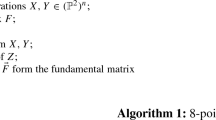Abstract
Fundamental matrix, drawing geometric relationship between two images, plays an important role in 3-dimensional computer vision. Degenerate configurations of space points and two camera optical centers affect stability of computation for fundamental matrix. In order to robustly estimate fundamental matrix, it is necessary to study these degenerate configurations. We analyze all possible degenerate configurations caused by twisted cubic and give the corresponding degenerate rank for each case. Relationships with general degeneracies, the previous ruled quadric degeneracy and the homography degeneracy, are also reported in theory, where some interesting results are obtained such as a complete homography relation between two views. Based on the result of the paper, by applying RANSAC for degenerate data, we could obtain more robust estimations for fundamental matrix.
Access this chapter
Tax calculation will be finalised at checkout
Purchases are for personal use only
Preview
Unable to display preview. Download preview PDF.
Similar content being viewed by others
References
Bartoli, A., Sturm, P.: Non-linear estimation of the fundamental matrix with minimal parameters. Pattern Analysis and Machine Intelligence 26, 426–432 (2004)
Bober, M., Georgis, N., Kittler, J.: On accurate and robust estimation of fundamental matrix. Computer Vision and Image Understanding 72, 39–53 (1998)
Frahm, J., Pollefeys, M.: Ransac for (quasi-)degenerate data (qdegsac). Computer Vision and Pattern Recognition 1, 453–456 (2006)
Hartley, R.: In defense of the eight-point algorithm. Pattern Analysis and Machine Intelligence 19, 580–593 (1997)
Luong, Q.T., Faugeras, O.: The fundamental matrix: Theory, algorithms, and stability analysis. International Journal of Computer Vision 17, 43–76 (1996)
Torr, P.H.S., Murray, D.W.: The development and comparison of robust methods for estimating the fundamental matrix. International Journal of Computer Vision 23, 271–300 (1997)
Torr, P.H.S., Zisserman, A., Maybank, S.J.: Robust detection of degenerate configurations while estimating the fundamental matrix. Computer Vision and Image Understanding 71, 312–333 (1998)
Zhang, Z.: Determining the epipolar geometry and its uncertainty: A review. International Journal of Computer Vision 27, 161–195 (1998)
Huang, T.S., Ahuja, J.N.: Motion and structure from two perspective views: algorithms, error analysis, and error estimation. Pattern Analysis and Machine Intelligence 11, 451–476 (1989)
Chum, O., Werner, T., Matas, J.: Two-view geometry estimation unaffected by a dominant plane. Computer vision and Pattern recognition, 772–779 (2005)
Hartley, R., Zisserman, A.: Multiple view geometry in computer vision. Cambridge University Press, Cambridge (2000)
Buchanan, T.: The twisted cubic and camera calibration. Computer Vision, Graphics and Image 42, 130–132 (1988)
Wu, Y., Li, Y., Hu, Z.: Detecting and handling unreliable points for camera parameter estimation. International Journal of Computer Vision 79, 209–223 (2008)
Maybank, S.: Theory of reconstruction from image motion. Springer, Heidelberg (1992)
Luong, Q.T., Faugeras, O.: A stability analysis of the fundamental matrix. In: Eklundh, J.-O. (ed.) ECCV 1994. LNCS, vol. 800, pp. 577–588. Springer, Heidelberg (1994)
Hartley, R.: Ambiguous configurations for 3-view projective reconstruction. In: Vernon, D. (ed.) ECCV 2000. LNCS, vol. 1842, pp. 922–935. Springer, Heidelberg (2000)
Hartley, R., Kahl, F.: Critical configurations for projective reconstruction from multiple views. International Journal of Computer Vision 71, 5–47 (2006)
Maybank, S., Shashua, A.: Ambiguity in reconstruction from images of six points. In: International Conference on Computer Vision, pp. 703–708 (1992)
Fischler, M., Bolles, R.: Random sample consensus: a paradigm for model fitting with applications to image analysis and automated cartography. Communications of the ACM 24, 381–395 (1981)
Semple, J.G., Kneebone, G.T.: Algebraic projective geometry. Oxford University, Oxford (1952)
Kahl, F., Henrion, D.: Globally optimal estimates for geometric reconstruction problems. International Journal of Computer Vision 74, 3–15 (2007)
Author information
Authors and Affiliations
Editor information
Editors and Affiliations
Rights and permissions
Copyright information
© 2010 Springer-Verlag Berlin Heidelberg
About this paper
Cite this paper
Lan, T., Wu, Y., Hu, Z. (2010). Twisted Cubic: Degeneracy Degree and Relationship with General Degeneracy. In: Zha, H., Taniguchi, Ri., Maybank, S. (eds) Computer Vision – ACCV 2009. ACCV 2009. Lecture Notes in Computer Science, vol 5995. Springer, Berlin, Heidelberg. https://doi.org/10.1007/978-3-642-12304-7_7
Download citation
DOI: https://doi.org/10.1007/978-3-642-12304-7_7
Publisher Name: Springer, Berlin, Heidelberg
Print ISBN: 978-3-642-12303-0
Online ISBN: 978-3-642-12304-7
eBook Packages: Computer ScienceComputer Science (R0)




